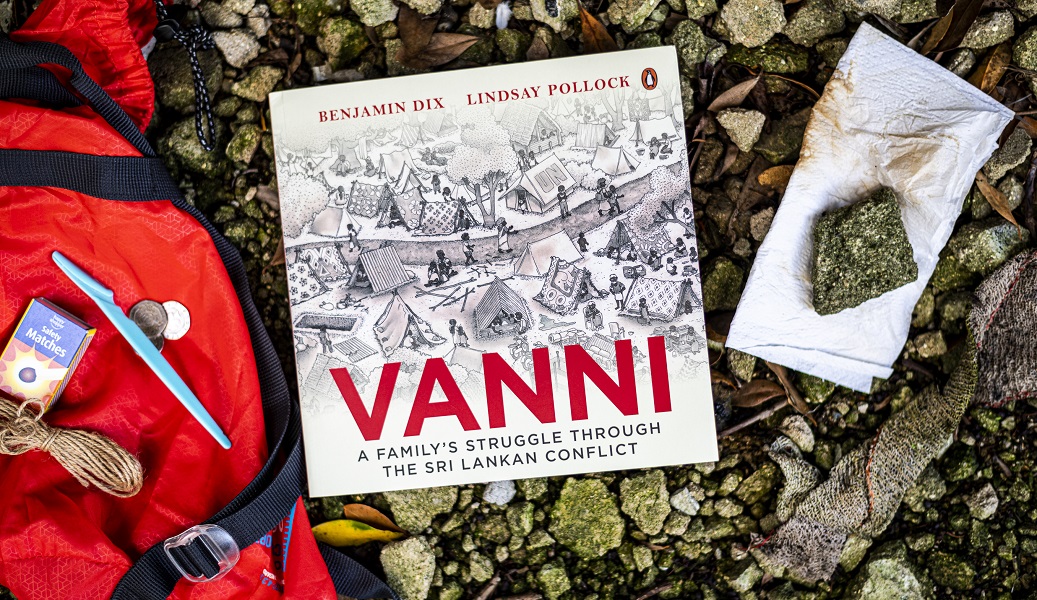
Vanni is a powerfully illustrated story of war, survival and trauma suffered by countless Tamil civilians in Sri Lanka. A story that is crucial to unbury and remember, the graphic novel format makes it accessible to an even wider range of audience.
Here are some heartrending ways in which Vanni makes a statement on the brutal human impact of war and trauma:
Becoming an Orphan
On 22nd January 2009, as Selvi and Prem get caught in a gunfire that sfinds them witnessing the brutal death of a mother with an infant boy. They take the boy with them, who has now lost his mother and become an orphan.
Mass Casualties
Loss of life on a large scale is always a by-product of war. “In August 2006, Sri Lankan Army (SLA) shelling killed 61 children.”
Displacement
War uproots homes. Not only do the people have their security and safety taken away from them, they are also displaced from their own homes. “Entire villages and communities took to the road with all they could carry. On the main arteries between jungle, fields, and lagoons, they came together in vast crowds – a mass of weary, desperate people in search of a safe haven.”
Fear
“With shells flashing across the lagoon and falling like rain behind them, Indran and his family had fled their home in Pooneryn. […] Indran had dug their bunker on the first day. […]When he heard explosions, they would scramble for the bunker. In seconds, they would be under the ground. Sometimes they stayed there for hours, listening for gunfire or shelling.”
Safety
A sentiment that consumes civilians during war is a perpetual desperation for safety.
“On 21st January 2009, a ‘safe zone’ was announced. The government declared that an area of 35 Square kilometres – within territory still nominally held by the Tigers – would not be shelled.
Desperate civilians hurried to follow the government’s instructions.”
Emotional Numbing
Consumed and driven by a basic need for day-to-day survival, war also concurrently breeds an arguable numbness to sights of pain and suffering, since they become so commonplace. “The weeks dragged past. It became unremarkable to see people shuffling past with horrible injuries. Despite their fears, the Ramachandrans were often bored. In the same dense jungle around them, the battle pounded on.”
Forced Labour
Forced recruitment is also commonplace within ranks of the army, since war needs as many people as possible to fight on the battlefields. Civilians fall victim to this in large numbers. “Some Tiger soldiers used coercion, threats (and some were even alleged to have shot at civilians) to prevent [the civilians’ leaving the conflict zone and fleeing to the Army. Civilians were also used for forced labour, building military defences and children were forced into the dwindling LTTE ranks.”
Estrangement
Towards the end of the narrative, we see the main character, Antoni, forced to leave behind his wife Rajini and daughter Theepa in Chennai, India – in an arrangement he hoped was temporary – to go to London with the help of a people-smuggler in an effort to seek permanent asylum for his family. Familial separation is a painful reality in the aftermath of war, driven by a desperation to find a new home and start life afresh. “We [Rajini, Theepa and I] talked, we cried a lot. I didn’t want to leave them ever again but –
What choice did we have?
There was no other way.”
These instances give just a glimpse into the life-long horrors and human impact of war through the ordeal of The Ramachandrans in the 2009 war in Sri Lanka. Join them in an emotionally impactful narrative in Vanni.









